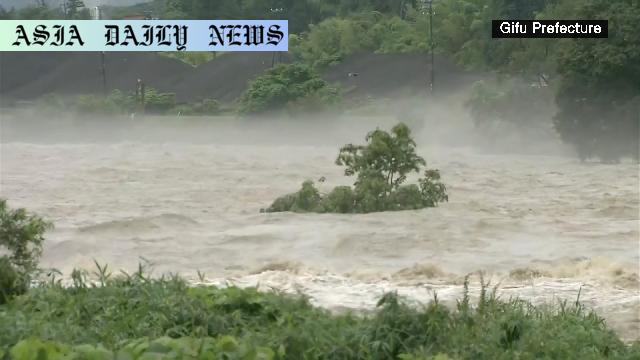Heavy Rains: Weather authorities in Japan urge caution against landslides, flooding, and swollen rivers due to record rainfall.
- Heavy rains across Japan caused a significant risk of landslides and floods.
- Unstable atmospheric conditions were driven by a low-pressure system and tropical depression.
- Gifu Prefecture recorded nearly 400mm of rainfall in 24 hours.
- Weather authorities urge immediate precautions during severe weather signs.

Unstable Atmospheric Conditions Take a Toll on Japan
Heavy rains have swept over Japan, causing widespread disruptions and raising alarms about safety. The Japan Meteorological Agency (JMA) has warned against imminent dangers including landslides, flood risks, and swollen rivers. From western to northern Japan, unstable atmospheric conditions have established their ground due to the influence of a low-pressure system and a tropical depression that weakened from a typhoon. These weather systems have brought intense rainfall across a wide range of regions, including Gifu Prefecture, which recorded nearly 400 millimeters of rain in just a 24-hour span.
This excessive rainfall has paved the way for multiple risks. The ground in several areas has turned weak, escalating the possibilities of landslides. Moreover, urban regions and low-lying areas have been put on high alert as flooding becomes increasingly likely. Rivers across the country have started swelling, making it crucial for citizens to heed the warnings issued by local authorities. The unprecedented rainfall events underscore the need for preparedness and effective safety measures to prevent crises triggered by natural disasters.
Regions Under Threat from Heavy Rain
Rain clouds enveloped significant parts of Japan, including the Kanto region in eastern Japan and the Kyushu area to the southwest. Tokyo, a bustling metropolis, was not spared; the city’s Nerima Ward saw 32.5 millimeters of rainfall within a single hour. However, the impacts were most severe in parts of Gifu Prefecture. In Ogaki City’s Kamiishizu area, an astounding 389 millimeters of rain was recorded over a period of 24 hours. These figures highlight the urgency to address the immediate and long-term challenges posed by unpredictable weather conditions.
The JMA predicts that the unstable atmospheric state will persist, meaning Japan is likely to experience more downpours accompanied by thunder until Thursday at the least. This prolonged phase of inclement weather compounds the hazards for many regions across the country. Experts have pointed out signs of impending danger, such as sudden darkening of the sky or a cold breeze, urging people to seek shelter without delay when these occur. Such early signs serve as critical indicators of potentially destructive weather events, like lightning, severe wind gusts, and even tornadoes.
Steps to Enhance Public Safety
Officials across Japan are urging residents to prioritize safety by remaining vigilant and responsive to weather advisories. Given the severe impact heavy rainfall can have, authorities have advised citizens to remain alert to ground movement, which could point to landslide activity. Additional emphasis has been placed on avoiding flood-prone zones and keeping away from rivers that are likely to overflow due to the intense downpours.
Emergency preparedness is essential in mitigating avoidable tragedies during extreme weather conditions. Local governments are enhancing public awareness through guidelines and real-time updates, while also mobilizing resources to ensure that assistance is readily available where needed. Likewise, individuals are encouraged to prepare emergency kits, stay informed about evacuation protocols, and heed the recommendations of emergency responders. An integrated approach between authorities and the public will be key in navigating the challenges posed by persistent rainfall and maintaining essential safety standards.
Analyzing the Broader Impact of Weather Extremes
These events are not just an ordinary occurrence but indicate the growing unpredictability and intensity of weather systems worldwide. As climate change accelerates, the frequency and intensity of weather events like the heavy rains in Japan are likely to increase. This presents a range of challenges for urban planning, disaster management, and environmental sustainability. The ongoing rains in Japan serve as a stark reminder of the importance of adapting strategies to cope with future risks.
Ultimately, the immediate and long-term solutions must be underpinned by robust and science-driven policy frameworks. These include investments in weather forecasting technologies, infrastructure enhancements, and sustainable development practices that address climate change’s root causes. Through collaboration between governments and international bodies, there is hope for creating systems that safeguard vulnerable populations during times of crisis.



Commentary
The Urgency of Proactive Weather Preparedness
The continuous downpours in Japan underscore the critical need for proactive measures in weather preparedness. Events like this not only showcase the power of nature but also highlight the gaps in disaster prevention and response systems that must be addressed urgently. Heavy rains are not uncommon during certain seasons, but the increasing intensity and unpredictable nature of these weather patterns demand a re-evaluation of safety practices and urban infrastructure.
Public Caution and Awareness Saves Lives
The warnings issued by Japan’s Meteorological Agency are a model for how weather alerts can save lives when delivered efficiently. Cautioning residents about landslides, swelling rivers, and other related risks in a timely manner provides them an opportunity to take preparatory steps. However, the success of such advisories depends equally on public awareness and prompt action. Simple acts like seeking shelter when the skies darken could make the difference between safety and tragedy.
Investing in Resilience Against Weather Extremes
As we witness the growing impacts of global climate instability, the need for systemic investments in climate resilience becomes ever more apparent. Japan’s technological advancements in weather tracking and disaster preparedness should inspire other regions worldwide. However, alongside immediate solutions, holistic global strategies are essential to mitigate climate-induced risks. By addressing root causes, such as carbon emissions and unsustainable practices, and building resilient infrastructure, countries can equip themselves better against weather-related adversities.